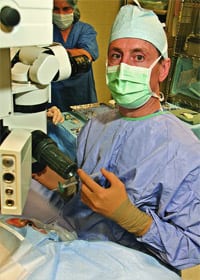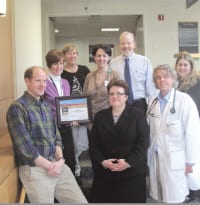New Eye Procedure — the Intraocular Implant — Offers Alternative to Lasik
HOLYOKE — For Dr. Kevin Hulseberg, a little patience paid big dividends for his patients.
Although in May, Hulseberg became one of the first Western Mass. physicians to perform a new version of an operation known an intraocular implant, he didn’t rush into learning the procedure when it was first developed in Europe a few years ago. The state-of-the-art process involves correcting nearsightedness by implanting a synthetic lens between the iris and the natural lens of the eye.
“It’s really new to our area,” said Hulseberg. “It’s only been around for about a year and a half in the U.S. and a bit longer overseas. But we wanted to wait before doing it so any potential problems would be worked out. We wanted to make sure it was something that would benefit our patients.”
Hulseberg’s approach clearly has paid off. On May 14, he performed two of these procedures at Holyoke Medical Center, and both have been successes. Just a week after the procedures, both patients were able to pass the Massachusetts driver’s license eye test without wearing contact lenses or glasses. And it’s not just the recovery time that is speedy: the procedure itself only takes 15-20 minutes and is done on an outpatient basis. The recovery after implantation is quick, with most people returning to their normal activities within one to two days. Both eyes are done in one session.
“The vision may be a little blurry the first day after the surgery, but after that it gets progressively better,” Hulseberg said. “I’m excited it’s working out well. It’s another alternative for those who don’t want Lasik.”
Hulseberg performed the first procedure of this type on his daughter, Sara Hulseberg, 25. Sara said she was able to return to her job as a physical therapist the very next day after the procedure, and had 20/20 vision within four days.
“And my vision was pretty bad before,” she said. “I was legally blind without contacts or glasses.”
Dr. Hulseberg took a certification course for the procedure earlier this year. It was a natural progression for him, he said, as performing an intraocular implant is very similar to cataract surgery.
“The incision is the same as standard cataract surgery, but you don’t have to remove anything,” he explained. “I just slide the lens into the space between the iris and natural lens. The lens is made out of a polymer material that is bio-compatible, so it doesn’t cause any inflammation or irritation of the eye.”
The procedure is an alternative to Lasik surgery, which, although safe and popular, can have a downside.
“With Lasik, you have to use a laser to change the shape of the cornea, and this can sometimes weaken the cornea,” Hulseberg said.
This new version of intraocular implants is also a step up from the original way they were done. The older procedure involved clipping the synthetic lens to the iris, which meant physicians had to make a much bigger incision. This sometimes could lead to irritation in the eye and distortion of the iris.
About one in four Americans, or approximately 75 million, is nearsighted.
Hulseberg said the best candidates for intraocular implants are nearsighted people age 21-40. After 40, people become presbyopic (a condition of aging that causes diminished eyesight due to a loss of elasticity of the crystalline lens), and there are other medical technologies that would serve them better, Hulseberg said. Studies have demonstrated that the majority of patients undergoing this type of surgery achieve significant increase in uncorrected visual acuity (i.e., vision without use of glasses or contacts).
For more information on the procedure, call (413) 536-8670.




Comments are closed.